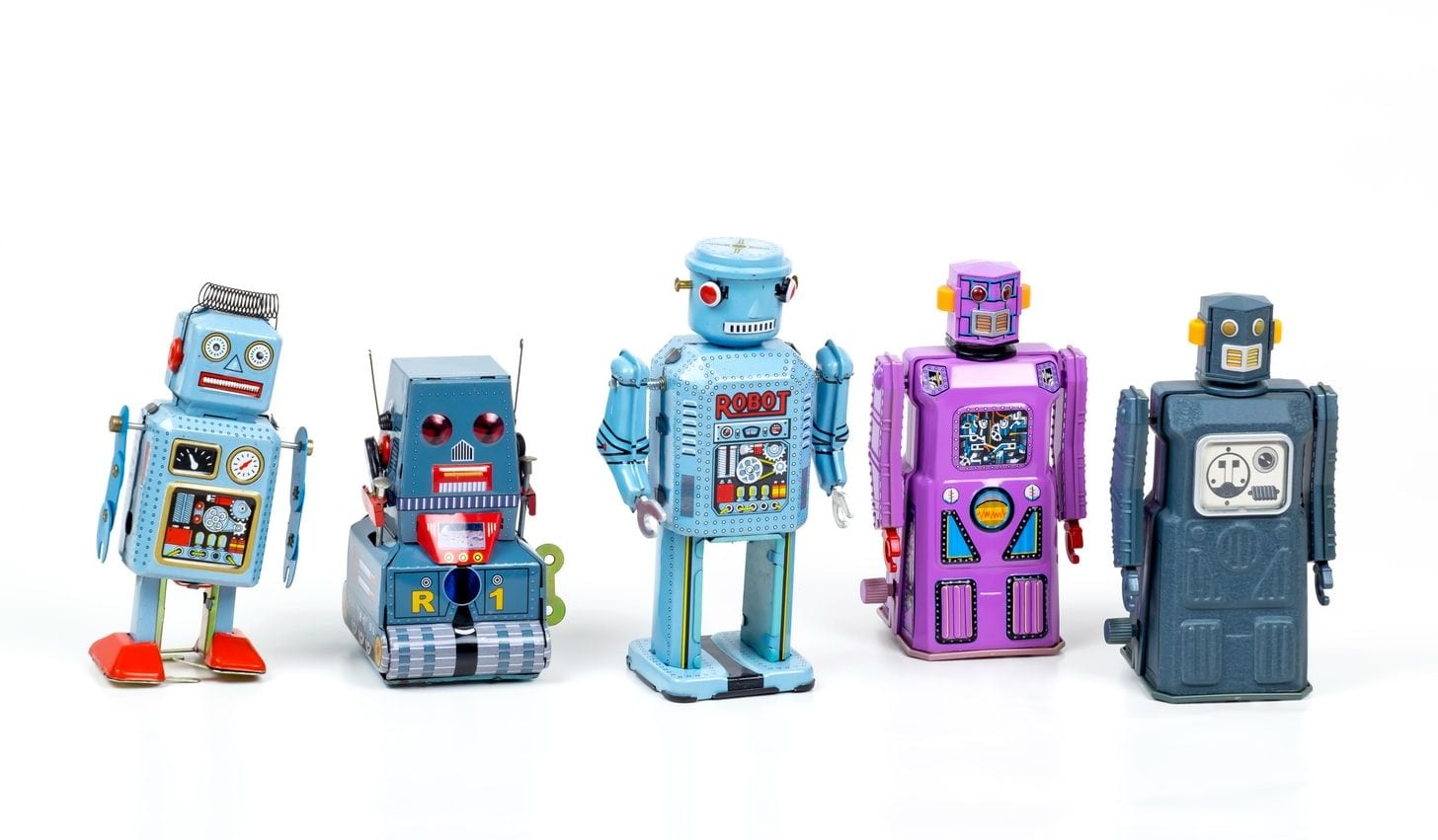In Will Smith’s 2004 sci-fi thriller/ Audi advert, I, Robot, we learn that ultimately technology will rise up to destroy us, and that our only saviour is a pair of Converse All Stars.
In the year 2035, VIKI (Virtual Interactive Kinetic Intelligence) is a highly evolved AI system that controls all the technology around us. She determines that, in order for humanity to survive, she must control it and occasionally kill bits of it off.

According to her logic, which is flawless, that’s the only way for us to go on as a species. And she’s probably right. Feelings and emotions do often get in the way of us making sensible decisions. It's why grown men punch horses and Donald Trump wins elections.
Chatbots take feelings out of it. They know the moves we should make, and try to take us on a logical journey through them.
If we’re having problems, they know we should read a help and support article. Want to change some details? They know we need to sign into our account. Thinking of leaving? They know they need to stop working and freeze our screen.
However, all too often those logical journeys fail to take into account our particular requirements. Their rigid structure is inaccessible, and their tone - or total lack of it - only adds to our frustrations.
Here I take a look at the issues with some chatbots today, the ones who do it well, and how we could all be doing it better in the future. It includes no further references to I, Robot, and for that I can only apologise.
Bad bot
Bad chatbots are enough to make your blood boil. I JUST WANT TO CHANGE MY MAILING ADDRESS, CONTACT LENS PROVIDER!
Here are my pet peeves that all bots should try and avoid.

Getting stuck in a chatbot cycle
The first problem we face with many chatbots is that they assume they’re your first point of contact. They’re not.
Most people would prefer to self-serve. 67% in fact. We’ll try and solve the problem ourselves before asking for help, and are generally tech-savvy enough to know how to do it. If we end up speaking to a chatbot, it’s often because we’ve tried - and failed - to complete the task on our own.
If the chatbot responds to a query by sending you back to where you’ve just been, it creates a cycle of frustration. This, ultimately, will lead to a customer ignoring the chatbot altogether and opting to call customer service instead - the very thing the chatbot was designed to prevent.
Finding the chatbot is offline
If the self-service option is offline, people will be left with no option but to call in - or worse - say nasty things about your brand on social media.
Offline chatbots leads to frustrated customers, especially when they’re likely already peeved by this point anyway. According to this very informative slideshow, 1 out of 26 unhappy customers will complain - the rest will just churn and head to a competitor.
It’s six times more expensive to attract a new customer than to keep hold of an existing one. If they leave because they don’t like your product or have found something cheaper, so be it. If they leave because your online support is never online, that’s a reason to hang your head in shame.
The bot says you need to call
The whole purpose of self-service is to eliminate the need for a call centre. Paying a building full of people answering the phones is expensive. Just one customer service agent could set you back £25,142 a year. If you times that by 17,500 - the number of call centre staff BT has working in the UK - you’re looking at an annual payout of over £439m.
Suddenly it makes sense why you pay so much for your fibre broadband.
Chatbots are much cheaper to run. They don’t need pensions or DSE approved computer chairs, and hardly ever ask for a promotion. However, if they get stuck on a question and insist you call, you’ll not only be paying for their server, you’ll also be paying for the human to pick up the pieces.
If the customer was annoyed by the time they got to your robot, imagine how they’ll feel when they have to do the one thing they were aiming to avoid.
Better bot
A good chatbot solves problems. It offers a solution to a situation that could otherwise have caused a sad customer, an angry phone call or a nasty tweet. Here's how:

The chatbot is injected with your tone of voice
This one should be easy. No matter which server you’re using to host your chatbot, you should be able to change the kind of responses it offers.
Chatbots generally work on a script, or a command list. When customers ask them a question, it triggers one of a series of set responses. You can create those responses yourself, filling them with your tone of voice and ensuring they sound like ‘you’ at every touchpoint.
If your brand is all chipper and quirky on your website, but then boring and dour on your live chat, it just won’t add up. Your tone of voice needs to be consistent everywhere people see it for it to make an impact. Don’t be all “LOVE CATS AS MUCH AS US? You’ll look purrfect in this super cute top with an ameowsing design,” and then make your chatbot more, “Hello customer 23. Please confirm your issue. Does not compute.”
Robots need a personality too. Just because a response is automated, doesn’t mean it can’t feel human.
The chatbot puts you through to a real person
The best chatbots I’ve experienced ask you a few basic questions, then put you through to a real life human who’s on hand to help. It’s just like speaking to someone on the phone, only with two advantages: You don’t have to face the crippling anxiety of speaking to another human, and the customer service rep can be having a number of conversations at the same time. With multiple tickets open, they can do the job of numerous phone handlers, saving you money in the process.
Not only is it good for bizniz, it’s also great for the user experience. You get specific answers to your questions and you get the support you actually need, not what the automated replies think you need.
The other day I did a very grown-up thing and bought a house. I needed my bank to raise my daily transaction limit so we could send over our deposit. Proper terrifying, for future reference, clicking ‘approve’ on that amount of money. It took us a mere 30 seconds to start speaking to someone. After sending a picture of my fiancée posing with her driving license to prove we weren’t committing fraud, it was all sorted.
Live chat had helped us buy a house and months of wallpaper stripping.
The chatbot manages expectations
Whenever you have live chat in place, there’s every chance there will be delays. Chatters gotta chat, ya know? But instead of just telling people live chat is unavailable, the best bots manage expectations. If a message says something like, “Our team is busy right now, but we should be with you in the next 10 minutes,” you’re not just fobbing customers off - you’re giving them a reason to stick around. If the time counts down, even better. Show people you care about their concerns and reassure them you’ll be there to help soon.
The chatbot spots problems
Smart chatbots use machine learning. They pick up on what your customers are talking about and ensure their level of urgency is met with the right response. By using text mining, they can register when certain keywords are used and make sure they get prioritised accordingly.
Take cancelling a contract for example. If a customer tells a chatbot they want to do that, and the chatbot just sends them to a help and support article about how, there's every chance they're off. However, if a chatbot picks up on the word 'cancelling' and directs them to call, someone might be able to twist their arm.
Let your robot pick up the brunt of the work, let people come in when they're needed.
Chatbots outside of customer service

If, like me, you are over the age of 30, you may well remember AOL Instant Messenger. AIM, if you will. If, also like me, you didn’t have too many friends in your youth, you may also remember SmarterChild.
SmarterChild was a chatbot designed to offer basic conversation on AIM or MSN Messenger. He had a few quirks, like acting like a parent if you ever swore, and being immune to the many attempts to troll him.
At his height he had over 30 million online friends, and was a depressingly welcome relief when everyone else was appearing offline,
SmarterChild was in many ways the precursor to another chatbot you probably know about: Siri. Apple’s virtual assistant came to life in 2010, starting the race that has brought about Alexa and Google Home.
Go into many homes and you’ll be able to ask a bot to play some music, set an alarm, tell you the news, predict the weather and even turn up your heating.
Chatbots are everywhere, and they’re only getting smarter.
Our favourite on-site support services
I asked the team which chatbots they liked the best and why. Sadly, they could all remember ones they hated much more vividly. I have blanked out the names of the brands, just in case they one day want to work with us. (We can make your live support better though, just ask.)
Alex Hickson, Senior PR Exec:
“BLANK’s one sort of lures you into thinking you can actually talk to a real person then you just loop with a couple of churned out phrases.”
Alice Buttery, PR Exec:
“You can't ever get in contact with a real person. If you're not happy with the response it just loops back to the start.”
Amy Jones, Digital Designer:
“Omgggg BLANK is a BLANKING nightmare. You just get looped round in circles. Must only have 20 banked responses that point you back to the pages that (9 times out of 10) you've just come from.”
The only brands that we gave a glowing review were Monzo and Eve Sleep. Banking and beds, you’re doing things right.
Offer live chat on your site?
We can make it better. If you want automated responses writing, a tone of voice creating or your website content designing so people can help themselves, just get in touch.
You might get an automated response saying we’ll get back to you, but honestly, we will.
















